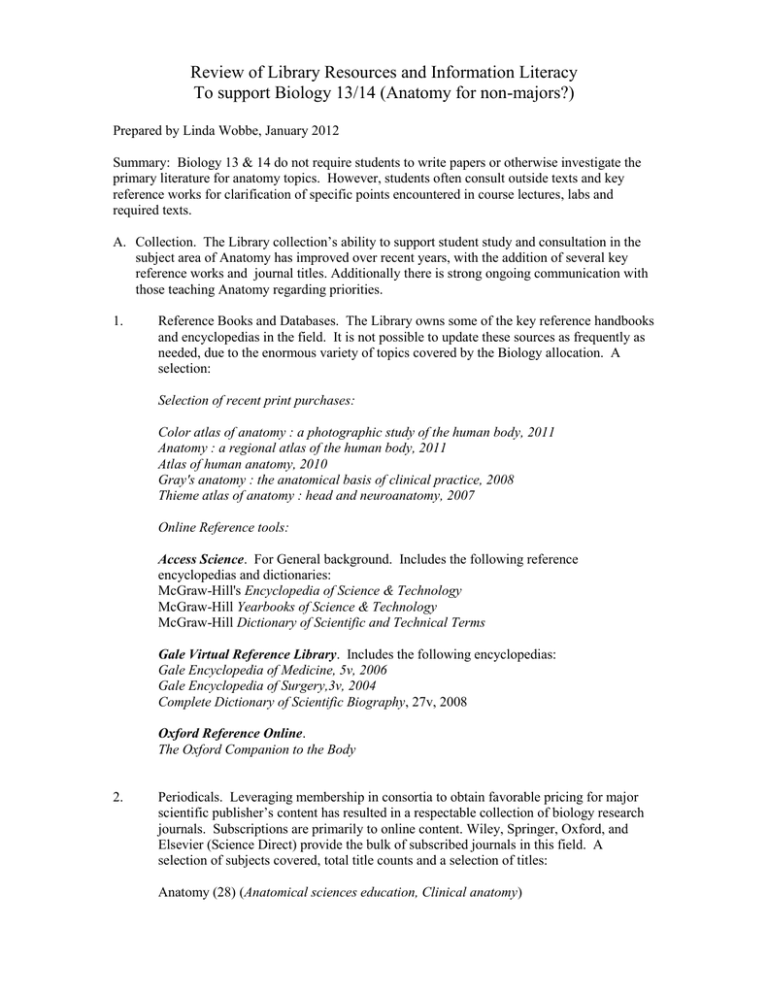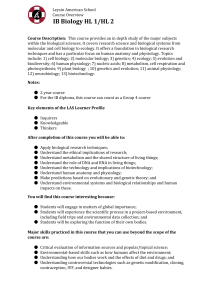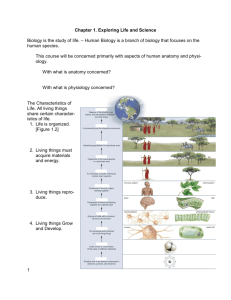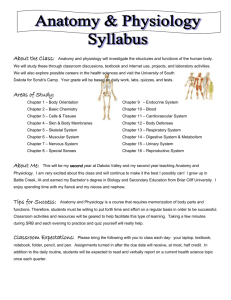Bio 13-14 Library Review
advertisement

Review of Library Resources and Information Literacy To support Biology 13/14 (Anatomy for non-majors?) Prepared by Linda Wobbe, January 2012 Summary: Biology 13 & 14 do not require students to write papers or otherwise investigate the primary literature for anatomy topics. However, students often consult outside texts and key reference works for clarification of specific points encountered in course lectures, labs and required texts. A. Collection. The Library collection’s ability to support student study and consultation in the subject area of Anatomy has improved over recent years, with the addition of several key reference works and journal titles. Additionally there is strong ongoing communication with those teaching Anatomy regarding priorities. 1. Reference Books and Databases. The Library owns some of the key reference handbooks and encyclopedias in the field. It is not possible to update these sources as frequently as needed, due to the enormous variety of topics covered by the Biology allocation. A selection: Selection of recent print purchases: Color atlas of anatomy : a photographic study of the human body, 2011 Anatomy : a regional atlas of the human body, 2011 Atlas of human anatomy, 2010 Gray's anatomy : the anatomical basis of clinical practice, 2008 Thieme atlas of anatomy : head and neuroanatomy, 2007 Online Reference tools: Access Science. For General background. Includes the following reference encyclopedias and dictionaries: McGraw-Hill's Encyclopedia of Science & Technology McGraw-Hill Yearbooks of Science & Technology McGraw-Hill Dictionary of Scientific and Technical Terms Gale Virtual Reference Library. Includes the following encyclopedias: Gale Encyclopedia of Medicine, 5v, 2006 Gale Encyclopedia of Surgery,3v, 2004 Complete Dictionary of Scientific Biography, 27v, 2008 Oxford Reference Online. The Oxford Companion to the Body 2. Periodicals. Leveraging membership in consortia to obtain favorable pricing for major scientific publisher’s content has resulted in a respectable collection of biology research journals. Subscriptions are primarily to online content. Wiley, Springer, Oxford, and Elsevier (Science Direct) provide the bulk of subscribed journals in this field. A selection of subjects covered, total title counts and a selection of titles: Anatomy (28) (Anatomical sciences education, Clinical anatomy) Physiology (251) (Acta physiologica, American Journal of Physiology, Annual review of physiology, BMC physiology, Clinical biomechanics, Comparative biochemistry and physiology, European journal of applied physiology, Experimental physiology, Human physiology, Journal of comparative physiology, Journal of physiology, Skeletal muscle.) 3. Periodical Citation Databases. The Library subscribes to the major online databases in the field, Web of Science / Science Citation Index and Biological Abstracts. Many faculty also use PubMed as their primary search engine, and the Library has worked with National Library of Medicine to provide the CheckSMCHoldings feature at a special url for PubMed. It is hoped that the Library can extend the Web of Science/Science Citation Index back-file to 1970 or earlier. Current back-file is to 1980+. B. Library Materials purchases and usage. 1. Library expenditures. It is not possible to provide a break-down of expenditures for anatomy and related topics. Here is the most recent data for biology overall. 2009-10 for Biology Icode2=C a. Expenditures, 2009-10, New books and videos…………………..…$ 5,307.56 b. Expenditures 2009-10,digital resource subscriptions…………………$ 12,736.68 c. Expenditures 2009-10, periodical subscriptions…..…………………$ 17,302.97 d. Expenditures 2009-10, standing orders………………………………..$ 1,312.98 e. TOTAL………………………………………………...$ 36,874.23 4.25% of the overall library materials expenditures 2. Collection size. a. Total Biology Icode2=C books in Albert as of 7/1/2011…………….……5,532 b. % of total book collection in Albert as of 7/1/2011…………………….… 2.4 % c. Books added 2010-11………………………………………………………731 d. Albert search results “Anatomy”……………………………………………520 3. Library usage. a. Biology majors student circulation, 2010/11……………………………646 books (1.4% of the total circulation; ranked 21 of 26) b. Biology books checked out (any patron) 2010/11……………………….745 books (3% of the total circulation; ranked 13 of 29) c. Biology reference questions 2010/11………………………………………39 (1% of the total; ranked 20 of 29) C. Library Instruction / Information Literacy. It is not anticipated that students in Biology 13/14 will have information literacy instruction in these courses. D. Recommendations. 1. The Faculty Library Liaison and faculty assigned to teach the various anatomy courses continue to work with the Librarian Subject Selector to select and purchase the most relevant new books and updated reference handbooks and encyclopedias.





